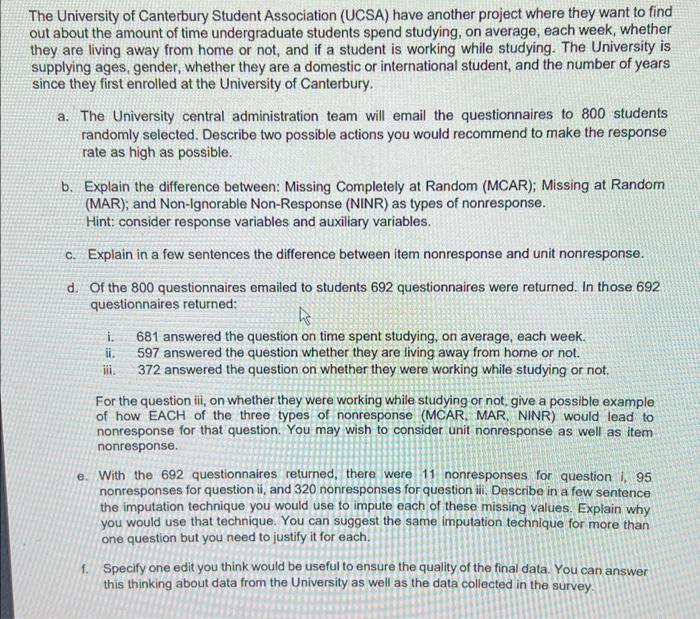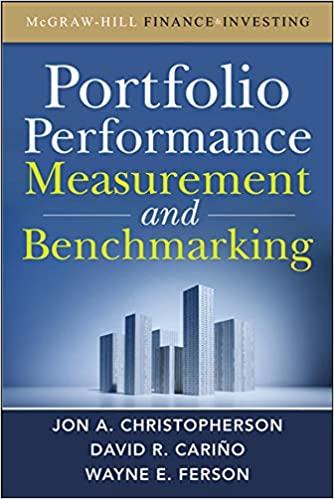The University of Canterbury Student Association (UCSA) have another project where they want to find out about the amount of time undergraduate students spend studying, on average, each week, whether they are living away from home or not, and if a student is working while studying. The University is supplying ages, gender, whether they are a domestic or international student, and the number of years since they first enrolled at the University of Canterbury. a. The University central administration team will email the questionnaires to 800 students randomly selected. Describe two possible actions you would recommend to make the response rate as high as possible. b. Explain the difference between: Missing Completely at Random (MCAR); Missing at Random (MAR); and Non-Ignorable Non-Response (NINR) as types of nonresponse. Hint: consider response variables and auxiliary variables. c. Explain in a few sentences the difference between item nonresponse and unit nonresponse. d. Of the 800 questionnaires emailed to students 692 questionnaires were returned. In those 692 questionnaires returned: Is i. 681 answered the question on time spent studying, on average, each week. 597 answered the question whether they are living away from home or not. ii. iii. 372 answered the question on whether they were working while studying or not. For the question iii, on whether they were working while studying or not, give a possible example of how EACH of the three types of nonresponse (MCAR. MAR, NINR) would lead to nonresponse for that question. You may wish to consider unit nonresponse as well as item nonresponse. e. With the 692 questionnaires returned, there were 11 nonresponses for question 1, 95 nonresponses for question ii, and 320 nonresponses for question iii. Describe in a few sentence the imputation technique you would use to impute each of these missing values. Explain why you would use that technique. You can suggest the same imputation technique for more than one question but you need to justify it for each. f. Specify one edit you think would be useful to ensure the quality of the final data. You can answer this thinking about data from the University as well as the data collected in the survey. The University of Canterbury Student Association (UCSA) have another project where they want to find out about the amount of time undergraduate students spend studying, on average, each week, whether they are living away from home or not, and if a student is working while studying. The University is supplying ages, gender, whether they are a domestic or international student, and the number of years since they first enrolled at the University of Canterbury. a. The University central administration team will email the questionnaires to 800 students randomly selected. Describe two possible actions you would recommend to make the response rate as high as possible. b. Explain the difference between: Missing Completely at Random (MCAR); Missing at Random (MAR); and Non-Ignorable Non-Response (NINR) as types of nonresponse. Hint: consider response variables and auxiliary variables. c. Explain in a few sentences the difference between item nonresponse and unit nonresponse. d. Of the 800 questionnaires emailed to students 692 questionnaires were returned. In those 692 questionnaires returned: Is i. 681 answered the question on time spent studying, on average, each week. 597 answered the question whether they are living away from home or not. ii. iii. 372 answered the question on whether they were working while studying or not. For the question iii, on whether they were working while studying or not, give a possible example of how EACH of the three types of nonresponse (MCAR. MAR, NINR) would lead to nonresponse for that question. You may wish to consider unit nonresponse as well as item nonresponse. e. With the 692 questionnaires returned, there were 11 nonresponses for question 1, 95 nonresponses for question ii, and 320 nonresponses for question iii. Describe in a few sentence the imputation technique you would use to impute each of these missing values. Explain why you would use that technique. You can suggest the same imputation technique for more than one question but you need to justify it for each. f. Specify one edit you think would be useful to ensure the quality of the final data. You can answer this thinking about data from the University as well as the data collected in the survey







